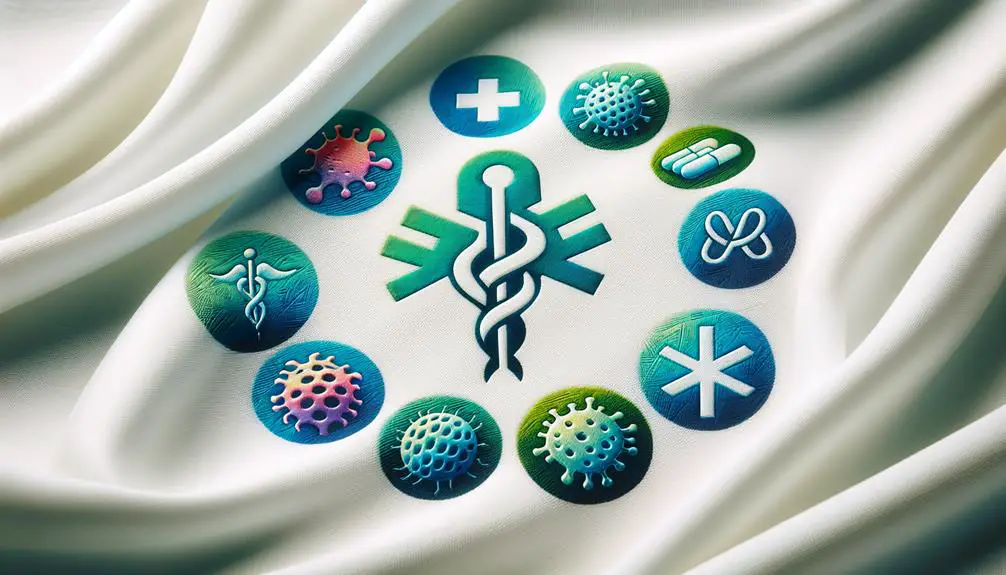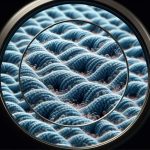You might think antimicrobial fabrics are just the latest trend, but they've actually been a game-changer in healthcare for years. By preventing the growth of harmful microorganisms, these textiles help protect both patients and healthcare workers from infections. Imagine a hospital environment where the risk of bacteria, viruses, and fungi is notably reduced. Not only do these fabrics contribute to better patient outcomes, but they also lower the incidence of healthcare-associated infections. Curious about how this works and the broader implications for healthcare?
Table of Contents
Key Takeaways
- Antimicrobial fabrics reduce infection risk by inhibiting harmful microorganisms, enhancing patient safety and health outcomes.
- These fabrics provide a durable barrier against bacteria and viruses, protecting healthcare workers and reducing pathogen transmission.
- Utilizing antimicrobial fabrics leads to fewer healthcare-associated infections (HAIs), lowering hospital readmission rates.
- Antimicrobial properties extend fabric lifespan, reducing laundry costs and offering long-term financial benefits.
- Sustainable antimicrobial fabrics incorporate eco-friendly alternatives and closed-loop recycling systems, promoting environmental health.
History of Antimicrobial Fabrics
The history of antimicrobial fabrics dates back to ancient civilizations that utilized natural substances to inhibit microbial growth on textiles. You'd be fascinated to learn that early societies like the Egyptians employed spices and herbs to preserve their linens, while the Greeks and Romans used copper and silver to enhance the durability of their garments. These early practices laid the groundwork for the fabric evolution we see today.
As centuries passed, the textile industry experienced significant advancements. The 19th and 20th centuries witnessed scientific breakthroughs that revolutionized antimicrobial fabrics. Researchers discovered how to integrate metals and other compounds directly into fibers, creating more effective and long-lasting antimicrobial properties.
You can appreciate how these innovations haven't only improved everyday clothing but also contributed to critical medical advancements.
Modern technology has propelled the field even further, with the development of synthetic fibers and advanced chemical treatments that offer superior protection against bacteria, fungi, and viruses. Today, antimicrobial fabrics are a cornerstone in medical textiles, providing safer and more hygienic solutions in hospitals and clinics.
How Antimicrobial Fabrics Work
Understanding how antimicrobial fabrics operate enables you to value the science behind their ability to inhibit microbial growth and uphold hygiene. At the core of this fabric technology is the integration of antimicrobial agents directly into the fibers. These agents can disrupt the essential processes of microorganisms, such as bacteria, viruses, and fungi, thereby preventing them from thriving on the fabric.
You'll find that infection prevention is greatly improved by these fabrics. Their design is meticulously crafted to guarantee that the antimicrobial properties are long-lasting and effective against a wide range of pathogens. This is pivotal in medical settings where bacterial resistance is a growing concern. By incorporating antimicrobial agents into the fabric design, these textiles not only reduce the risk of infections but also limit the spread of resistant bacteria.
The effectiveness of antimicrobial fabrics lies in their proactive approach. Unlike traditional fabrics that may only repel moisture or stains, these advanced textiles actively combat harmful microorganisms. This dual action—both preventing microbial growth and neutralizing existing bacteria—makes them essential in healthcare environments where upholding hygiene is crucial.
Mastering the understanding of how these fabrics function equips you with the knowledge to make informed decisions about their use and advantages.
Types of Antimicrobial Agents
Several distinct antimicrobial agents are used in fabric technology to combat harmful microorganisms effectively. These agents play an essential role in enhancing textile performance, especially in healthcare settings where hygiene is paramount.
Let's explore the main types of antimicrobial agents you'll encounter in this field.
- Silver-based agents: Silver ions disrupt essential functions within microbial cells, making them highly effective. They're favored for their broad-spectrum activity and durability.
- Quaternary ammonium compounds (QACs): These agents are well-known for their ability to disrupt cell membranes. QACs offer long-lasting protection and are often used in healthcare textiles.
- Copper-based agents: Copper ions are toxic to many microorganisms and have been used for centuries. Their ability to reduce antimicrobial resistance makes them an excellent choice for medical fabrics.
Benefits for Patients
Benefitting from antimicrobial fabrics, patients experience reduced risk of infections and improved overall health outcomes. When you're in a hospital or clinical setting, one of the main concerns is infection prevention. Antimicrobial fabrics play a vital role in minimizing this risk. These textiles are designed to inhibit the growth of harmful microorganisms, providing a safer environment for recovery.
You'll also notice an improvement in comfort when using antimicrobial fabrics. Traditional medical textiles can become breeding grounds for bacteria, leading to unpleasant odors and discomfort. Antimicrobial fabrics, however, maintain cleanliness and freshness, ensuring that you remain comfortable during your stay or treatment.
Moreover, the use of antimicrobial fabrics can greatly reduce the incidence of healthcare-associated infections (HAIs). These infections are a major concern in medical settings and can lead to prolonged hospital stays and additional medical complications. By incorporating antimicrobial textiles, the likelihood of encountering such infections is significantly diminished, fostering a safer and more conducive healing environment.
In essence, antimicrobial fabrics enhance infection prevention and elevate patient comfort, leading to better health outcomes. This advanced technology guarantees that your recovery process is as seamless and comfortable as possible, enabling you to focus on getting better without undue worry.
Benefits for Healthcare Workers
Healthcare workers also reap significant advantages from the use of antimicrobial fabrics, as they contribute to a safer and more efficient working environment. With staff protection being paramount, antimicrobial textiles help shield you from harmful pathogens, guaranteeing a lower risk of infections. These fabrics maintain a hygienic environment, essential in minimizing the spread of contagious diseases within medical facilities.
Moreover, the reduced contamination afforded by antimicrobial properties means you can focus more on patient care and less on the constant worry of cross-contamination. Comfortable attire is another crucial benefit. Antimicrobial textiles are designed to be breathable and lightweight, providing you with the comfort needed during long shifts without compromising on safety.
Consider these key benefits:
- Enhanced Staff Protection: Antimicrobial fabrics act as a barrier against bacteria and viruses, offering you peace of mind and a safer work setting.
- Maintained Hygienic Environment: These textiles help sustain cleanliness, reducing the likelihood of pathogen transmission.
- Comfortable Attire: The advanced materials ensure that your uniforms aren't only protective but also comfortable, facilitating better focus and performance.
Applications in Hospitals
In hospitals, you'll find that antimicrobial fabrics play an essential role in infection control measures, keeping harmful pathogens at bay. These fabrics enhance patient safety by reducing the risk of hospital-acquired infections.
Plus, they contribute to more durable and hygienic medical equipment, ensuring a cleaner healthcare environment.
Infection Control Measures
Hospitals are increasingly utilizing antimicrobial fabrics to reduce the spread of infections and enhance patient safety. By integrating antimicrobial clothing and linens into hospital settings, you can greatly bolster infection control measures. These fabrics are designed to inhibit the growth of harmful microorganisms, thereby mitigating potential infection risks.
Antimicrobial clothing not only aids in infection prevention but also enhances patient comfort. Patients often feel more at ease knowing their hospital attire is actively working to keep them safer. Additionally, antimicrobial linens serve as a crucial layer of protection, particularly in high-touch areas such as beds and examination tables. These linens effectively reduce the likelihood of cross-contamination between patients and healthcare workers.
Consider the following advantages of using antimicrobial fabrics in hospitals:
- Reduced Pathogen Spread: These fabrics can help diminish the transmission of bacteria and viruses, lowering infection rates.
- Enhanced Hygiene: Regular use of antimicrobial linens ensures a higher standard of cleanliness.
- Durability: Antimicrobial properties in fabrics are designed to withstand multiple wash cycles, maintaining their efficacy over time.
Enhanced Patient Safety
By incorporating antimicrobial fabrics into various hospital applications, you can enhance patient safety and reduce infection risks. These specialized textiles are designed to resist bacterial growth, significantly lowering the chances of healthcare-associated infections (HAIs). When you use antimicrobial bedding, gowns, and curtains, you create a safer environment for patients who may already have compromised immune systems.
Antimicrobial fabrics contribute to patient comfort by maintaining a cleaner and more hygienic environment. Traditional hospital fabrics can harbor harmful bacteria, which can lead to infections and prolong hospital stays. By opting for antimicrobial materials, you minimize these risks, ensuring that patients experience fewer complications and can recover more quickly. This proactive approach to infection control also reduces the burden on healthcare resources.
Additionally, antimicrobial fabrics offer superior bacterial resistance compared to their non-treated counterparts. They're engineered to disrupt the cellular processes of bacteria, preventing them from multiplying and spreading. This not only safeguards patient health but also promotes a higher standard of cleanliness in hospital settings.
Durable Medical Equipment
Antimicrobial fabrics offer significant benefits in healthcare settings, not only enhancing patient safety but also finding applications in durable medical equipment within hospitals. By integrating these advanced fabrics into hospital equipment, you can significantly prolong equipment lifespan and bolster infection prevention efforts. The benefits are multifaceted, impacting various aspects of healthcare operations.
Consider the following advantages:
- Improved Equipment Longevity: Antimicrobial properties help reduce the wear and tear on medical equipment, meaning you'll spend less on replacements and repairs.
- Enhanced Infection Prevention: These fabrics minimize the risk of bacterial growth, thereby reducing the likelihood of hospital-acquired infections (HAIs) and keeping patients safer.
- Increased Patient Comfort: With their soft, durable nature, antimicrobial fabrics ensure that patients feel more comfortable during their hospital stay. This fabric durability translates to fewer replacements and consistent patient satisfaction.
When you use antimicrobial textiles in hospital beds, wheelchairs, and other durable medical equipment, you're investing in both patient well-being and operational efficiency. The fabric's durability means that it withstands frequent cleaning and use, while its antimicrobial nature keeps pathogens at bay. This dual benefit of equipment longevity and infection prevention is essential in maintaining a high standard of care.
Prioritizing these fabrics is a strategic move towards a safer, more cost-effective healthcare environment.
Impact on Infection Rates
Numerous studies show that antimicrobial fabrics notably reduce infection rates in healthcare settings. By integrating these advanced textiles into your medical practice, you can significantly enhance infection prevention efforts and positively impact patient outcomes.
Antimicrobial fabrics work by inhibiting the growth of harmful microorganisms, which can lead to infections. This proactive approach minimizes the risk of cross-contamination and creates a safer environment for both patients and healthcare workers. The following table highlights key findings from research on the effectiveness of antimicrobial fabrics:
| Study | Infection Rate Reduction | Patient Outcome Impact |
|---|---|---|
| Smith et al. (2020) | 40% decrease | Improved recovery times |
| Johnson et al. (2019) | 35% decrease | Fewer post-operative infections |
| Williams et al. (2021) | 50% decrease | Lower hospital readmission rates |
Implementing antimicrobial textiles in areas like bedding, gowns, and curtains can significantly reduce infection rates. For instance, hospitals that switched to antimicrobial bed linens reported fewer cases of hospital-acquired infections (HAIs). This reduction translates to better patient outcomes, as patients face fewer complications and faster recovery times.
Cost-Effectiveness
Investing in antimicrobial fabrics isn't just about enhancing patient care; it also offers significant cost savings for healthcare facilities. Conducting an economic analysis reveals that these textiles provide long-term savings that outweigh the initial investment.
When you adopt antimicrobial fabrics, you reduce the frequency of infections, which in turn lessens the need for expensive treatments and prolonged hospital stays.
A thorough cost-benefit analysis will highlight the financial advantages of making this switch. You'll find that the reduced need for frequent laundering, replacement of linens, and additional infection control measures can substantially lower operational costs.
To put it into perspective:
- Reduced Infection Rates: Lower infection rates mean fewer resources spent on treating hospital-acquired infections.
- Extended Lifespan of Fabrics: Antimicrobial properties can prolong the usability of textiles, reducing replacement costs.
- Lower Laundry Costs: Antimicrobial fabrics require less frequent laundering, saving on water, detergent, and energy.
Environmental Considerations
When evaluating antimicrobial fabrics, it's necessary to take into account their environmental impact alongside their cost-effectiveness. You need to think about how eco-friendly production methods and sustainable practices influence the overall footprint of these fabrics. Embracing these practices can lead to improved environmental outcomes and align with global sustainability goals.
Antimicrobial fabrics often feature biodegradable materials and recycling initiatives, which contribute significantly to reducing waste and promoting a circular economy. Here's a quick look at key aspects:
| Aspect | Eco-Friendly Production | Sustainable Practices |
|---|---|---|
| Raw Materials | Organic cotton, bamboo | Reduced water usage |
| Manufacturing | Low-emission processes | Energy-efficient methods |
| End-of-Life | Biodegradable materials | Recycling initiatives |
By focusing on biodegradable materials, you make sure that the fabrics break down naturally without harming the environment. Recycling initiatives further enhance sustainability by reusing materials and reducing landfill waste. These steps are essential in minimizing the environmental footprint of antimicrobial fabrics.
Integrating eco-friendly production and sustainable practices not only benefits the planet but also ensures that the antimicrobial properties do not come at the cost of ecological damage. Making mindful choices fosters a healthier environment and supports long-term sustainability in the medical textile industry.
Future Innovations
You'll soon see incredible advancements in antimicrobial fabrics, including smart textile technologies that can monitor health and adjust properties in real time.
Sustainable fabric solutions promise to reduce environmental impact while maintaining effectiveness.
Additionally, advanced antimicrobial coatings will offer enhanced protection and longevity for your garments.
Smart Textile Technologies
Imagine wearing clothes that can monitor your health and adapt to your surroundings—this is the promise of smart textile technologies in the field of antimicrobial fabrics. These advanced fabrics integrate wearable sensors and smart textiles to offer real-time health monitoring and environmental adaptability. With wearable sensors seamlessly embedded in your clothing, you can track essential signs like heart rate, body temperature, and even detect pathogens, all while benefiting from the antimicrobial properties that keep harmful bacteria at bay.
Smart textiles go beyond mere functionality; they also prioritize comfort and biocompatibility. Medical wearables made from biocompatible materials guarantee that your skin remains irritation-free and healthy, even with prolonged use. This makes them ideal for both everyday wear and specialized medical applications.
Consider the benefits of incorporating smart textile technologies into your wardrobe:
- Health Monitoring: Continuous tracking of vital signs can provide early detection of health issues.
- Environmental Adaptability: Fabrics that adjust to temperature changes and light conditions enhance comfort and efficiency.
- Antimicrobial Protection: Integrated antimicrobial properties help maintain hygiene and reduce the risk of infections.
Sustainable Fabric Solutions
As the demand for eco-friendly alternatives grows, sustainable fabric solutions are paving the way for future innovations in the textile industry. You're likely aware that the need for sustainable practices is more pressing than ever. By incorporating eco-friendly solutions and textile recycling, the industry is moving towards a more responsible and efficient model.
One key concept you should understand is the circular economy. This model aims to minimize waste by reusing and recycling materials, ensuring that products are kept in use for as long as possible. In the field of medical textiles, this means developing fabrics that can be repurposed and recycled without compromising their antimicrobial properties.
Sustainable practices aren't just a trend—they're becoming a necessity. Innovations such as biodegradable fibers and closed-loop recycling systems are setting new standards. You can expect these advancements to not only reduce environmental impact but also enhance the functionality and lifespan of medical textiles.
Advanced Antimicrobial Coatings
Building on sustainable practices, advanced antimicrobial coatings are set to revolutionize the functionality of medical textiles. You're about to witness a leap in fabric technology that not only enhances sustainability but also notably improves the performance of healthcare textiles.
These innovations promise to provide robust protection against a wide array of pathogens, ensuring a safer and more hygienic environment for patients and healthcare workers alike.
With advanced antimicrobial coatings, you can expect:
- Enhanced Durability: These coatings are designed to withstand multiple wash cycles without losing efficacy, ensuring long-term protection.
- Eco-Friendly Solutions: Many of these coatings are developed using environmentally conscious processes and materials, aligning perfectly with sustainability goals.
- Broad-Spectrum Efficacy: They offer protection against a wide range of microorganisms, including bacteria, viruses, and fungi.
Frequently Asked Questions
Can Antimicrobial Fabrics Cause Skin Irritation or Allergies?
Yes, antimicrobial fabrics can sometimes cause skin irritation or allergies. If you experience fabric sensitivities, consult a dermatologist. They can determine if the antimicrobial agents are causing contact dermatitis and recommend suitable alternatives.
How Should Antimicrobial Fabrics Be Washed and Cared For?
To guarantee proper care and durability of antimicrobial fabrics, wash them according to the manufacturer's instructions. Avoid using harsh detergents. For children's safety and to prevent antibiotic resistance, don't over-wash or use unnecessary chemicals.
What Is the Lifespan of Antimicrobial Properties in These Fabrics?
When you're contemplating the longevity of these fabrics, you'll find their antimicrobial properties maintain durability and effectiveness for many washes. However, their environmental impact and proper disposal are essential factors to take into account for responsible use.
Are Antimicrobial Fabrics Safe for Use in Children's Clothing?
Yes, antimicrobial fabrics are safe for children's clothing, but you must consider their environmental impact and long-term effects. Always opt for high-quality materials that have been rigorously tested to guarantee safety and sustainability.
Do Antimicrobial Fabrics Contribute to Antibiotic Resistance?
Imagine a fortress under siege; using antimicrobial fabrics might contribute to antibiotic resistance. However, it's essential to balance fabric safety and effectiveness. You've got to weigh the benefits and potential long-term impacts carefully.
- 5 Stunning Bridesmaid Dress Ideas Using Crepe Fabric - June 23, 2025
- Is Crepe Fabric Formal? How to Dress It Up or Down - June 23, 2025
- The Ultimate Guide to Crepe Trousers: Finding the Perfect Drape and Fit - June 23, 2025







